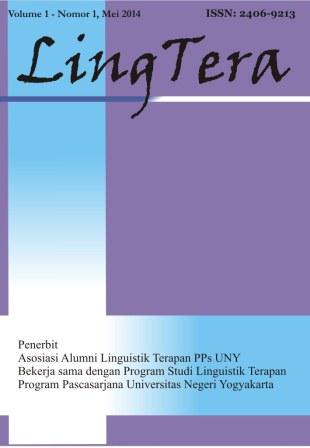Interactional dominance in legal discussions on YouTube: A conversation analysis of the Vina murder case
DOI:
https://doi.org/10.21831/lt.v12i1.81258Keywords:
conversational dominance, Conversation Analysis, ethnomethodology, legal discussions, Vina murder caseAbstract
This study investigates the strategies employed by participants to assert dominance in a legal discussion featured in the YouTube video “Janggalnya Kasus Vina Menyasar ke Mana-mana.” Adopting an ethnomethodological approach grounded in Conversation Analysis (CA), the study identifies key dominance strategies, including turn-taking control, interruptions, overlaps, topic shifting, and assertive language use. These strategies serve as critical tools for establishing dominance in high-stakes interactions such as legal debates. The analysis utilized the Jefferson Transcription System to examine how conversational control influences the progression and outcomes of legal discussions. Findings indicate that legal practitioners with institutional authority, expertise, or professional standing assert dominance through assertive language, strategic questioning, and frequent interruptions, while other participants assume less dominant roles. The study contributes to understanding how interactional dominance operates in formal legal settings, where institutional status and expertise often outweigh previously emphasized factors such as gender. These insights have practical implications for legal and communication professionals navigating power dynamics in formal discourse.
References
Alsahafi, M. (2024). Power relations in institutional discourse: A conversation analytic approach. Journal of Language Teaching and Research, 15(2), 634–643. https://doi.org/10.17507/jltr.1502.32
Arminen, I. (2006). Ethnomethodology and conversation analysis. In C. D. Bryant & D. L. Peck (Eds.), 21st century sociology: A reference handbook (Vol. 2, pp. 8–16). Thousand Oaks: Sage.
Coates, J. (1993). Women, men and language. London: Longman Group UK Limited.
Cutting, J. (2002). Pragmatics and discourse: A resource book for students. USA: Routledge.
Danescu-Niculescu-Mizil, C., Lee, L., Pang, B., & Kleinberg, J. (2012). Echoes of power: Language effects and power differences in social interaction. In Proceedings of the 21st International Conference on World Wide Web (pp. 699–708). Lyon, France. https://doi.org/10.1145/2187836.2187931
Deutsch, M. (2014). Cooperation, competition, and conflict. In P. T. Coleman, M. Deutsch, & E. C. Marcus (Eds.), The handbook of conflict resolution: Theory and practice (3rd ed., pp. 3–28). Jossey-Bass/Wiley.
Ehrlich, S. (2001). Representing rape: Language and sexual consent. London: Routledge.
Eades, D. (2010). Sociolinguistics and the legal process. Bristol: Multilingual Matters.
Fei, Z. (2010). An analysis of gender differences in interruption based on the American TV series Friends [Undergraduate thesis, Kristianstad University].
Ghilzai, S. A. (2015). Conversational analysis of turn-taking behavior and gender differences in multimodal conversation. European Academic Research, 3(9), 10100–10116.
Griffith, P. (2006). An introduction to English semantics and pragmatics. Edinburgh: Edinburgh University Press.
Heritage, J. (1984). Garfinkel and ethnomethodology. Polity Press.
Ismail, S., Oktadela, R., & Nawir, E. (2023). The influence of social media Facebook on the student’s learning motivation of FKIP Universitas Islam Riau. International Journal of Education and Digital Learning (IJEDL), 1(5), 155–160. https://doi.org/10.47353/ijedl.v1i5.25
Itakura, H. (2001). Describing conversational dominance. Journal of Pragmatics, 33, 1859–1880. https://doi.org/10.1016/S0378-2166(00)00082-5
Jacobi, T., & Rozema, K. (2018). Judicial conflicts and voting agreement: Evidence from interruptions at oral argument. Boston College Law Review, 59(7), 2259–2318.
Jacobi, T., & Schweers, D. (2017). Justice, interrupted: The effect of gender, ideology, and seniority at Supreme Court oral arguments. Virginia Law Review, 103(7), 1379–1496.
Locke, A. (2003). "If I’m not nervous, I’m worried, does that make sense?": The use of emotion concepts by athletes in accounts of performance. Forum Qualitative Sozialforschung / Forum: Qualitative Social Research, 4(1). https://doi.org/10.17169/fqs-4.1.752
Li, H. O.-Y., Bailey, A., Huynh, D., & Chan, J. (2020). YouTube as a source of information on COVID-19: A pandemic of misinformation? BMJ Global Health, 5(5), e002604. https://doi.org/10.1136/bmjgh-2020-002604
Maltz, D. N., & Borker, R. A. (1982). A cultural approach to male-female miscommunication. In J. Gumperz (Ed.), Language and social identity (pp. 196–216). Cambridge University Press. https://doi.org/10.1017/CBO9780511620836.013
Mulyani, A. D., Suryasuciramdhan, A., Fitrianingsih, I., & Alfayeed, M. (2024). Analisis framing film Vina: Sebelum 7 hari dalam media sosial TikTok dan X. Filosofi: Publikasi Ilmu Komunikasi, Desain, Seni Budaya, 1(3), 26–33.
Oliveira, R. M. D., & Beuren, I. M. (2024). Cooperative or competitive style of conflict management? Effects on information sharing and agricultural cooperatives’ performance. Cadernos EBAPE.BR, 22(1), e2022-0013. https://doi.org/10.1590/1679-395120230013x
Pakzadian, M., & Tootkaboni, A. A. (2018). The role of gender in conversational dominance: A study of EFL learners. Cogent Education, 5(1), 1560602. https://doi.org/10.1080/2331186X.2018.1560602
Pires, F., Masanet, M. J., & Scolari, C. A. (2019). What are teens doing with YouTube? Practices, uses and metaphors of the most popular audio-visual platform. Information, Communication & Society, 24(9), 1175–1191. https://doi.org/10.1080/1369118X.2019.1672766
Sacks, H., Schegloff, E. A., & Jefferson, G. (1974). A simplest systematics for the organization of turn-taking for conversation. Language, 50(4), 696–735. https://doi.org/10.2307/412243
Sari, P. P. N., Adnyani, N. L. P. S., & Paramarta, I. M. S. (2021). Conversation analysis: Turn taking on Indonesia Lawyer Club talk show. Lingua Scientia, 28(1), 47–57. https://doi.org/10.23887/ls.v28i1.30924
Schegloff, E. A. (1992). Repair after next turn: The last structurally provided defense of intersubjectivity in conversation. American Journal of Sociology, 97(5), 1295–1345. https://doi.org/10.1086/229903
Schegloff, E. A. (2000). Overlapping talk and the organization of turn-taking for conversation. Language in Society, 29(1), 1–63. https://doi.org/10.1017/S0047404500001019
Saed, H. A., Haider, A. S., Al-Salman, S., & Hussein, R. F. (2021). The use of YouTube in developing the speaking skills of Jordanian EFL university students. Heliyon, 7(7), e07543. https://doi.org/10.1016/j.heliyon.2021.e07543
Shams, M., Shams, S. A., & Khan, U. (2021). Conversational dominance in mix gendered Pakistani political TV talk shows. Global Social Sciences Review (GSSR), 6(2), 406–417. https://doi.org/10.31703/gssr.2021(VI-II).40
Stenstrom, A. (1984). Questions and responses in English conversation. Malmö: Liber Förlag.
Tannen, D. (1993). The relativity of linguistic strategies: Rethinking power and solidarity in gender and dominance. In D. Tannen (Ed.), Gender and conversational interaction (pp. 165–188). Oxford University Press.
tvOneNews. (2024, May 21). [FULL] Janggalnya Kasus Vina Menyasar ke Mana-mana | Catatan Demokrasi tvOne [YouTube video]. https://youtu.be/_Hk-AgMWMa0?feature=shared
Yuliana, V. (2021). Conversational dominance and politeness strategy on a political discussion among peers. Indonesian JELT: Indonesian Journal of English Language Teaching, 16(1), 67–87. https://doi.org/10.25170/ijelt.v16i1.2553
Zimmermann, D. H., & West, C. (1996). Sex roles, interruptions and silences in conversation. In Amsterdam studies in the theory and history of linguistic science series 4 (pp. 211–236). John Benjamins BV.
Downloads
Published
How to Cite
Issue
Section
Citation Check
License
Copyright (c) 2025 Martin Martin, Antonius Suratno

This work is licensed under a Creative Commons Attribution-ShareAlike 4.0 International License.
LingTera allows readers to read, download, copy, distribute, print, search, or link to its articles' full texts and allows readers to use them for any other lawful purpose. The journal allows the author(s) to hold the copyright without restrictions. Finally, the journal allows the author(s) to retain publishing rights without restrictions.
- Authors are allowed to archive their submitted articles in an open-access repository.
- Authors are allowed to archive the final published article in an open-access repository with an acknowledgment of its initial publication in this journal.

Psychology, Evaluation, and Technology in Educational Research is licensed under a Creative Commons Attribution-ShareAlike 4.0 International License.
Based on a work at https://petier.org/index.php/PETIER.









